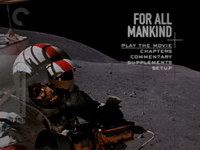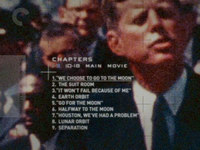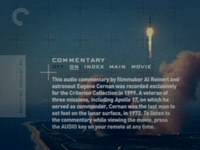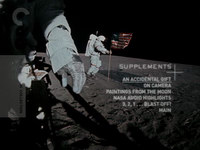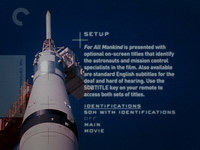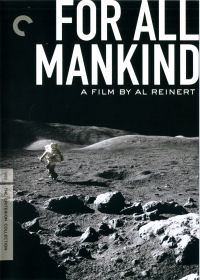
31.01.2010 #480en
English Translation 2.9.2013
by Guido Bibra
• Audio commentary featuring Reinert and Apollo 17 commander Eugene A. Cernan
• An Accidental Gift: The Making of "For All Mankind" Documentary
• On Camera, a collection of excerpted, on-screen interviews with fifteen of the Apollo astronauts
• New video program about Al Bean's artwork, accompanied by a gallery of his paintings
• NASA Audio highlights and liftoff footage
• Optional on-screen identification of astronauts and mission control specialists
• Plus: a booklet featuring essays by film critic Terrence Rafferty and Al Reinert
![]() Der Film
Der Film
When John F. Kennedy had sworn in the American nation on the Moon race against the USSR in September 1962, he did not know if NASA's scientists and technicians would really be able to reach this goal before the end of the decade. After Kennedy's tragic assassination in 1963 the space race had to go on, because the USA had no other choice than to try and get to the Moon before Russia. After countless unmanned and manned flights of the Mercury, Gemini and Apollo space programs, the Moon was finally orbited by American astronauts in 1968 with the successful landing following the next summer in July 1969. Meanwhile the Russian's effort to reach the moon had mostly disintegrated, but in the four years between 1968 to 1972, nine NASA spacecraft had reached the moon, six landed and twelve astronauts became moon walkers.
All missions had been extensively documented with photography, film and television broadcasts by NASA and the astronauts themselves, but once the space race was over, most of this material had vanished in the archives and was only seen in small excerpts. This was not NASA's fault at all, because as a taxpayer-funded agency their archives were open for all earnest requests, but more a problem of a general space weariness of the public, which had already been noticeable during the last few Apollo missions. After the last human had walked on the Moon in December 1972, there were only three more manned American spaceflights to the Skylab space station in earth orbit and a fourth flight, the Russian-American cooperation Apollo-Soyuz. Then American space program remained dormant more than half a decade until the Space Shuttle was ready.
But there was someone who was still interested in the Apollo missions: American Journalist Al Reinert, who had already written a couple of extensive articles about the Moon missions and even met some of the Astronauts themselves. It was from them that he heard about the then little know fact that during the moon missions not only thousands of photos were taken, but that also many miles of 16mm film were shot, most of which the public had seen only in small excerpts as low-quality third- or fourth-generation copies on television. Al Reinert began to wonder how these films would look in better quality on a big screen and began to work on a way to show the NASA material to a wider audience.
But Reinert did not just want to make a conventional documentary about the Apollo missions - instead, his goal was to highlight the unique experience of the spaceflights and moonwalks. While conducting his many interviews with the astronauts, he noticed that each of them described their journeys to and on the Moon in a similar way - by this, the idea was born not to show all flights separately and potentially show a lot of overlapping footage, but instead to gather the best available material together for a big cross-section. Reinert also made the big step of letting the astronauts narrating their experiences as protagonists, but completely omitting their names to avoid any deliberate hero worship. The title of the ambitious project was For All Mankind, leaving aside the political dimension of the space and fully concentrating on the human aspect of spaceflight.
NASA's film archive was very helpful and open-minded towards Al Reinert's project and he even was able to persuade the space agency to let him copy the original 16mm negatives to 35mm for his film. This was something that had never been attempted before and was able to bring a whole new quality level to the footage. To document the whole process of spaceflight, not only footage from the journeys, but also from ground control and the launches was used to show reactions from both sides. Sadly, there was not as much 16mm footage from the moon surface itself because of the limited time frame and the television broadcasts, so Al Reinert had no other choice to also use the worse-looking, but not less fascinating video recordings. Only a little artistic freedom was necessary to make the best out of the available material, but nothing had been willfully falsified or changed. Except one reconstructed shot, in which Ken Mattingly's view of the Moon from the window of the spacecraft on the launchpad was described, everything was one hundred percent real.
The search for suitable material dragged on longer than initially planned. In the early 1980s, Al Reinert had approached British musician Brian Eno, who, as a pioneer of ambient music, was an ideal choice for the project, to work on a musical accompaniment for his movie. Eno had finished his compositions long before the movie itself was ready and released them as his 1983 album Apollo: Atmospheres and Soundtracks, while Al Reinert was still busy working on his film. The idea to even leave out the voiceover interviews of the astronauts and only use Brian Eno's music had, however, been discarded. Instead the original plan to use the astronaut's interviews as narration was brought back and together with the original radio communications and some other sound material found in the NASA archives a highly detailed soundtrack was created, together with the music highlighting the unique atmosphere of the movie.
Al Reinert and his small team were able to finish For All Mankind in time for the 20th anniversary of the first Moon landing in 1989. One of the first premieres took place in attendance of a group of former astronauts and other NASA staff, who in spite of Al Reinerts fears had absolutely nothing against his idea of the almost anonymised protagonists and were all completely in awe of For All Mankind. It was one of the first really comprehensive documentaries about the American spaceflight program and distanced itself in a refreshing way from typical cliches of the Genre. The bold concept to combine all spaceflight into a single huge mission had brilliantly worked and the absence of exaggerated emotions, pathos and patriotism made a documentary possible which was fully able to concentrate on the images mostly shown for the very first time to the public.
Although For All Mankind had not been a particular financial success, it had a huge influence on the documentary film genre and awakened a whole new interest in the history of spaceflight. Many other documentaries followed, but only few were able to come close to For All Mankind. In 1995, Al Reinert had been invited by Tom Hanks and Ron Howard to become a co-writer on Apollo 13, the dramatised account of the near-catastropy of what would have been the third moon flight - it was partly Reinert's expertise that made the high authenticity of the movie possible. He also became part of the writer's team working on the brilliant television follow-up From the Earth to the Moon. But even today, For All Mankind remains the most fascination documentary about the Apollo program ever made - never had the original NASA footage been presented in such a wonderful way.
![]() Die DVD
Die DVD
For All Mankind had already been released as a Laserdisc and VHS tape shortly after its premiere in 1989 followed by a first DVD by the Criterion Collection in 1999. For the 40th anniversary of the Moon landing Criterion had prepared an improved re-release as a DVD and Blu-Ray, not only sporting a vastly improved transfer, but also some additional extras, making it one of the best DVDs of the year 2009 and one disc that should be part of every collection.
The disc reviewed in this article is the DVD version of the 2009 re-release of For All Mankind, which has not many disadvantages compared to the parallel Blu-Ray release considering the low resolution of the source material. The DVD is just one disc and comes in a simple clear keepcase without any special packaging, but contains the same booklet as the Blu-Ray. Thanks to the simple, but elegant cover design the DVD looks all but cheap and fully lives up to Criterion's reputation. If the Criterion version is too expensive, there are also almost identical British DVD and Blu-Ray releases from Eureka, which have all the extras except the additional interviews and are also encoded in NTSC using the Criterion transfer, although the DVD for some reason only has a 2.0 soundtrack.
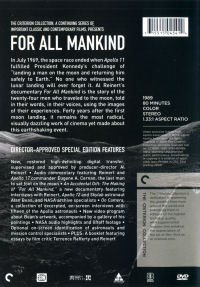
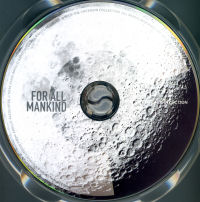
![]() Bild
Bild
For the re-release of For All Mankind, Criteron had commissioned a new high definition transfer from a 35mm interpositive. Because the source material is exclusively 16mm-film and video, the image quality is, of course, very limited, but considering the circumstances still impressive. Unfortunately Criterion has chosen to "windowbox" the image, so that the NTSC resolution of 720x480 pixels is even more reduced to 665x446, but luckily this is not a huge issue because of the low resolution of the source material. It is, however, still completely unnecessary, because today's television sets don't have very much overscan.
The 16mm footage looks remarkably good and has been carefully restored during the new transfer. The heavy film grain typical for this gauge has been left almost completely intact and only the many instances of physical dirt and damage have been successfully removed. Except some faintly visible tramlines in a few scenes the image is completely clean and almost unbelievable stable - there is no flutter or waving visible at all. For 16mm material, sharpness is surprisingly good, but does not fully extend to the DVD's resolution. Fortunately, there is no additional digital sharpening, so that the image looks very natural and film-like.
More problematic is the video material, which makes up about one third of the movie. The video cameras used in the Apollo missions only had a resolution of about 200 lines at most and the footage was, of course, not recorded on location, but transmitted directly from the spacecraft or from the surface of the moon, so it is understandable that it cannot even come close to the quality of the 16mm material. But Al Reinert had already made sure at the end of the 1980s that even these sequences were reproduced as good-looking as possible and that's how they are presented on this DVD. Extremely heavy video noise, drastically reduced sharpness and distinct smearing effects are visible, but these are television broadcasts from space and from the Moon and are seen here in the best shape available anywhere.
For All Mankind is really not high definition demo material, so it is somewhat surprising that Criterion had also released it on Blu-Ray. The DVD version is absolutely okay and presents the movie in the best possible quality - the only real complaint is the unnecessary windowboxing.
![]() Ton
Ton
For All Mankind had been released in 1989 with a Dolby Stereo mix in cinemas, which was reproduced as a 2-channel matrix-encoded surround track on the old DVD - but for the re-release, a completely new 5.1 mix from the 35mm magnetic tracks was prepared.
The single English soundtrack on this DVD has been encoded in Dolby Digital 5.1 with 448 kbit/s and has a surprisingly busy sound to offer, because For All Mankind had always sported a real movie soundtrack. The very active surround sound is not only created by Brian Eno's music, but also by very detailed sound design, which is especially noticeable during the control room sequences when the background noises and even the announcements are spread over all channels to provide a realistic sound. The surrounds are even used for some direct effects and during the rocket launch sequence the subwoofer also has something to do. The whole soundmix has a surprisingly modern feel to it.
The voiceovers of the astronauts were taken exclusively from Al Reinert's own interview recordings beginning in the late 1970s and are limited to the center channel. The voices are perfectly audible, but the quality varies very much between studio recording or very thin and scratchy. Compared to the very modern and advanced soundtrack itself, the voices sound a bit rustic, but also help to give the movie a very authentic atmosphere.
There are two different subtitle tracks on the DVD: the first identifies the appearing Astronauts and NASA staff by name and also displays the mission the current footage is from. The second track adds subtitles for the hard of hearing to this, also identifying the speaker of the voiceover.
![]() Bonusmaterial
Bonusmaterial
The bonus materials of the re-release were mostly taken from the previous edition from ten years earlier, but were also complemented with a couple of new extras, for which still was enough room on the single disc. Typically for Criterion, the menu design is simple, but functional and elegant.
The Audio Commentary with Al Reinert and astronaut Eugene Cernan was recorded for the 1999 DVD, but has not aged at all and is an outstanding extra equaling a second version of the movie with a different voiceover, doubling the runtime from 80 to 160 minutes. Al Reinert mostly talks about the making of the movie and his motivation, to bring the Apollo film material on the big screen, while Eugene Cernan recounts his experiences as a NASA astronaout and what it is really like to have set foot on the moon. Sometimes the commentary gets a little peculiar when Cernan begins to talk about faith and religion, but Reinert always steers clear of this and subtly changes the theme. It is a very human and less technical commentary, which like the movie itself focuses on the personal experiences of the astronauts.
An Accidental Gift: The Making of For All Mankind (31:59) with filmmaker Al Reinert, astronaut Al Bean, NASA film editors Don Pickard and Chuck Welch, film vault curator Morris Williams and lead librarian Mike Gentry was produced for the re-release of the DVD and is an ideal companion to the audio commentary. Despite the short length, this documentary is more than just a featurette, recounting not only the evolution of For All Mankind, but also the extensive search for the Apollo films and how Al Reinert found and selected them, including a fascinating visit to a NASA archive facility.
For On Camera (20:35) Al Reinert had collected archive interviews of the fifteen Apollo Astronauts Charlie Duke, Al Worden, Neil Armstrong, Pete Conrad, William Anders, James Lovell, Michael Collins, Stuart Roosa, Buzz Aldrin, Edgar Mitchell, Eugene Cernan, James Irvin, John Young, Frank Bormann and Rusty Schweickart. These were excerpted from three other documentaries, The Other Side of the Moon from 1989, Our Planet Earth from 1990 and The Wonder of it All from 2007 and also from two events celebrating the anniversary of Apollo 7 and 8. These are a brilliant addition to Al Reinert's movie, for which only sound recordings of the interviews exist.
In Paintings from the Moon (37:52) astronaut Al Bean introduces twenty-four of his wonderful spaceflight and moonwalk paintings and is also seen in an Intro (7:32), which is actually a mini-documentary for itself. This extra was already present on the old DVD, but has been remastered in 16:9.
The NASA Audio Highlights are 21 short clips of 10-20 seconds with the most famous bits from the Apollo radio communications - the choice is, however, a bit limited.
3, 2, 1... Blast Off! (2:36) is a short montage of the five different rocket types, which NASA had used in the moon race.
The last extra is something very rare today - a 25-page booklet with two essays, a few well-chosen photos and extensive information about the DVD itself.
